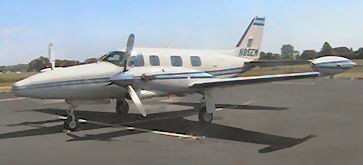Pilot, Passengers Fatally Injured When Piper Cheyenne Went Down During Departure
The NTSB's preliminary report from an accident in Fort Lauderdale, FL, involving a Piper Cheyenne indicates that the pilot of the airplane declared an emergency just after takeoff from Fort Lauderdale Executive Airport (KFXE), but did not indicate the nature of the emergency. The pilot and two passengers aboard the aircraft were fatally injured when the airplane wend down in an auto impound lot near the airport. A witness, also a pilot, said the airplane seemed to have difficulty climbing and clearing the obstacles at the end of the runway.

NTSB Identification: ERA13FA168
14 CFR Part 91: General Aviation
Accident occurred Friday, March 15, 2013 in Fort Lauderdale, FL
Aircraft: PIPER PA-31T, registration: N63CA
Injuries: 3 Fatal.
This is preliminary information, subject to change, and may contain errors. Any errors in this report will be corrected when the final report has been completed.
On March 15, 2013, about 1620 eastern daylight time, a Piper PA-31T (Cheyenne), N63CA, owned by M.A.S. Inc., was destroyed after it impacted the ground shortly after takeoff from the Fort Lauderdale Executive Airport (KFXE), Fort Lauderdale, Florida. The airline transport pilot and two passengers were fatally injured. Visual meteorological conditions prevailed and no flight plan had been filed for the local maintenance test flight that was conducted under the provisions of 14 Code of Federal Regulations Part 91.
According to initial information obtained from the Federal Aviation Administration (FAA), the airplane was purchased by its current owner during November 2012, and was being prepared for export to a customer in Columbia. The pilot planned to conduct a local test flight after avionics upgrades had been performed.
The owner stated that the airplane had undergone engine ground checks during the 4 days prior to the accident. He was not aware of any maintenance issues with the airframe or engines, which underwent detailed inspections at the time of the purchase.
The airplane departed from runway 8, a 6,002-foot-long, asphalt runway, and was expected to turn to the left for a northwest departure. Shortly after takeoff, witnesses observed the airplane make a steep right turn back toward the airport. The pilot transmitted that he was experiencing an "emergency;" however, he did not state the nature of the emergency prior to the accident. One witness, who was a pilot on an airplane that was parked in the mid-field run-up area at KFXE, stated that the accident airplane had difficulty climbing and barely cleared the obstacles located off the departure end of the runway. The airplane turned to the right, and "began to shake as if it was near stall speed". The airplane then appeared to stall, roll to the right about 90 degrees, and descend straight down toward the ground.

The airplane impacted into about seven parked vehicles, and came to rest inverted about .6 miles from the departure end of the runway. A postcrash fire consumed the airframe, with the exception of the right wingtip fuel tank, which was located about 20 feet south of the main wreckage. The right landing gear was found retracted in its respective gear well, while the structure around the nose and left main landing gears was compromised. The left and right flap actuator jackscrews indicated the flaps were in the retracted position. The airplane's stability augmentation system control arm was observed in the up (airplane stalled) position. It was noted that internal damage to both engines was consistent with rotation somewhere between the low to mid-range power setting, with more pronounced damage observed to the left engine. The three-bladed right propeller assembly did not display any significant evidence of twisting or rotational damage, while the left propeller assembly displayed evidence of twisting
and rotational damage.
Initial review of the airplane's maintenance logbooks revealed that it had been operated for about 135 hours during the previous 5 years, and 20 hours since its most recent documented phase inspections, which were performed on January 31, 2012.
(Piper Cheyenne pictured in file photo. Not accident airplane)
 Airborne-Flight Training 05.09.24: ERAU at AIAA, LIFT Diamond Buy, Epic A&P
Airborne-Flight Training 05.09.24: ERAU at AIAA, LIFT Diamond Buy, Epic A&P ANN's Daily Aero-Term (05.07.24): Hazardous Weather Information
ANN's Daily Aero-Term (05.07.24): Hazardous Weather Information Aero-News: Quote of the Day (05.07.24)
Aero-News: Quote of the Day (05.07.24) NTSB Final Report: Cessna 150
NTSB Final Report: Cessna 150 Aero-News: Quote of the Day (05.08.24)
Aero-News: Quote of the Day (05.08.24)




